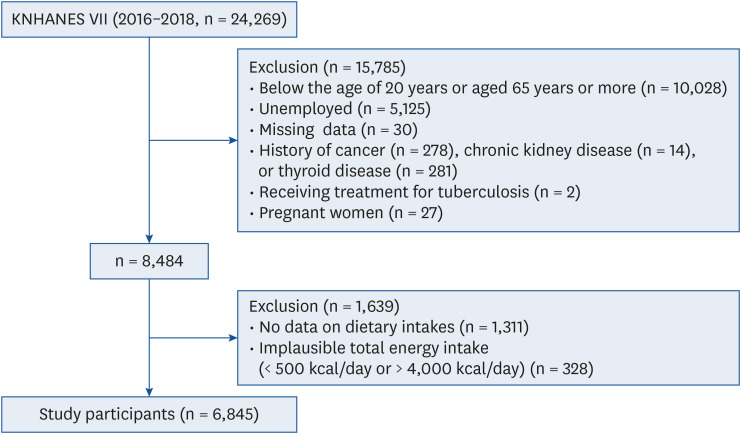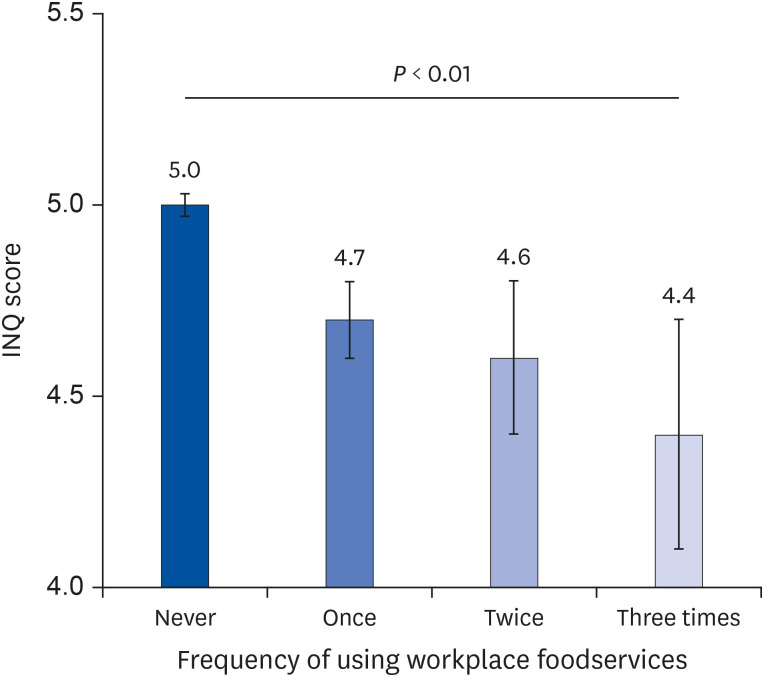Nutr Res Pract.
2022 Apr;16(2):248-259. 10.4162/nrp.2022.16.2.248.
Workplace foodservice meals are associated with higher nutritional quality among adult Korean workers: a nationwide cross-sectional study
- Affiliations
-
- 1Department of Family Medicine, Chung-Ang University Medical Center, Seoul 06973, Korea
- 2Department of Family Medicine, Chung-Ang University Medical Center, Chung-Ang University College of Medicine, Seoul 06973, Korea
- KMID: 2527814
- DOI: http://doi.org/10.4162/nrp.2022.16.2.248
Abstract
- BACKGROUND/OBJECTIVES
Adequate nutritional intake is essential for good health and well-being. We aimed to compare the nutrient intake from homemade meals, meals sourced externally (“eating out”), and meals from workplace foodservices, as well as the potential association between foodservices used and nutritional quality among adult Korean workers.
SUBJECTS/METHODS
We used data from the Korea National Health and Nutrition Examination Survey, a nationwide cross-sectional survey on the health and nutritional status of the Korean population. Data from 6,845 workers aged 20–64 years were included. A survey on dietary behavior and nutrition was conducted using the 24-h dietary recall method. Nutritional quality was examined using the index of nutritional quality (INQ) score. Higher INQ scores reflected poorer nutritional quality, with insufficient intake of a higher number of nutrients. Multivariate linear regression was used to identify the association between the foodservices used and INQ scores after adjusting for other covariates.
RESULTS
We found that foodservice users exhibited a higher 1-day intake of total energy and macronutrients (all P < 0.05) and lower INQ scores (P < 0.01) than non-users. The INQ scores for total daily meals decreased with the frequency of foodservice use (P < 0.01). A significant association was observed between the non-use of foodservices and INQ scores (β = 0.29, P < 0.01) after adjusting for other covariates.
CONCLUSIONS
The use of workplace foodservices contributed to higher dietary nutritional quality among workers. This study highlights the importance of expanding the scope of workplace foodservices to promote higher nutritional quality and healthy dietary habits among workers.
Figure
Reference
-
1. Kennedy G, Nantel G, Shetty P. Food and Agriculture Organization of the United Nations. Globalization of food systems in developing countries: impact on food security and nutrition. FAO Food Nutr Pap. 2004; 83:1–300. PMID: 19178111.2. Finkelstein J. Dining Out: a Sociology of Modern Manners. New York (NY): New York University Press;1989.3. Yoon S, Oh K. Dietary and nutritional status of Koreans based on the health plan 2020 nutrition indicators. Public Health Wkly Rep. 2018; 11:1483–1491.4. Food Information Statistics System (KR). Revenue by type of restaurant business (‘07~’16, 9th industry classification) [Internet]. Daejeon: Statistics Korea;2017. cited 2020 April 30. Available from: http://www.atfis.or.kr/html/report/2014/RPT_FFS_36_03.html.5. Kim HR. Current status of institutional foodservice and policy directions to improve the nutritional services. Issue Focus. 2012; 48:1–8.6. World Health Organization. Diet, Nutrition, and the Prevention of Chronic Diseases: Report of the Joint WHO/FAO Expert Consultation. Vol. 916. Geneva: WHO;2003. p. 4–10.7. Shetty P, Schmidhuber J. Nutrition, Lifestyle, Obesity, and Chronic Disease. New York (NY): United Nations;2011.8. Knoche K, Sochert R, Houston K. Promoting Healthy Work for Workers with Chronic Illness: a Guide to Good Practice. Perugia: European Network for Workplace Health Promotion;2012.9. Chu C, Breucker G, Harris N, Stitzel A, Gan X, Xueqi G, Dwyer S. Health-promoting workplaces—international settings development. Health Promot Int. 2000; 15:155–167.10. World Health Organization. 2008–2013 Action Plan for the Global Strategy for the Prevention and Control of Noncommunicable Diseases. Geneva: WHO;2008.11. Maes L, Van Cauwenberghe E, Van Lippevelde W, Spittaels H, De Pauw E, Oppert JM, Van Lenthe FJ, Brug J, De Bourdeaudhuij I. Effectiveness of workplace interventions in Europe promoting healthy eating: a systematic review. Eur J Public Health. 2012; 22:677–683. PMID: 21785115.12. Ni Mhurchu C, Aston LM, Jebb SA. Effects of worksite health promotion interventions on employee diets: a systematic review. BMC Public Health. 2010; 10:62. PMID: 20146795.13. Kim WG, Choi I, Yoon J. Nutritional quality of lunches consumed by Korean workers: comparison between institutional and commercial lunches. Nutr Res Pract. 2016; 10:606–615. PMID: 27909558.14. Kweon S, Kim Y, Jang MJ, Kim Y, Kim K, Choi S, Chun C, Khang YH, Oh K. Data resource profile: the Korea National Health and Nutrition Examination Survey (KNHANES). Int J Epidemiol. 2014; 43:69–77. PMID: 24585853.15. Korea Centers for Disease Control & Prevention. Korea National Health and Nutrition Examination Survey (KNHANES): design and methods [Internet]. Osong: Korea Centers for Disease Control & Prevention;2014. cited 2018 November 10. Available from: https://knhanes.kdca.go.kr/knhanes/eng/index.do.16. National Institute of Agricultural Sciences (KR). Standard Food Composition Table. Vol. 2. 8th rev. ed. Wanju: National Institute of Agricultural Sciences;2012. p. 3–13.17. Lim H, Cho G, Kim S. Evaluation of nutrient intake and diet quality of gastric cancer patients in Korea. Nutr Res Pract. 2012; 6:213–220. PMID: 22808345.18. Ministry of Health and Welfare (KR). The Korean Nutrition Society. Dietary Reference Intakes for Koreans 2020. Seoul: The Korean Nutrition Society;2020.19. U.S. Department of Health and Human Services. 2008 Physical Activity Guidelines for Americans: Be Active, Healthy, and Happy! ODPHP Publication No. U0036. Washington, D.C.: U.S. Department of Health and Human Services;2008.20. Hagströmer M, Oja P, Sjöström M. The International Physical Activity Questionnaire (IPAQ): a study of concurrent and construct validity. Public Health Nutr. 2006; 9:755–762. PMID: 16925881.21. Price S, Hartwell H, Hemingway A, Chapleo C. Workplace foodservice; perception of quality and trust. Appetite. 2016; 97:169–175. PMID: 26686582.22. Liu JL, Han B, Cohen DA. Associations between eating occasions and places of consumption among adults. Appetite. 2015; 87:199–204. PMID: 25558025.23. Sorenson AW, Wyse BW, Wittwer AJ, Hansen RG. An Index of Nutritional Quality for a balanced diet. New help for an old problem. J Am Diet Assoc. 1976; 68:236–242. PMID: 55430.24. Lassen AD, Fagt S, Lennernäs M, Nyberg M, Haapalar I, Thorsen AV, Møbjerg AC, Beck AM. The impact of worksite interventions promoting healthier food and/or physical activity habits among employees working ‘around the clock’ hours: a systematic review. Food Nutr Res. 2018; 62.25. Thorsen AV, Lassen AD, Tetens I, Hels O, Mikkelsen BE. Long-term sustainability of a worksite canteen intervention of serving more fruit and vegetables. Public Health Nutr. 2010; 13:1647–1652. PMID: 20444314.26. Roos E, Sarlio-Lähteenkorva S, Lallukka T. Having lunch at a staff canteen is associated with recommended food habits. Public Health Nutr. 2004; 7:53–61. PMID: 14972072.27. Korea Legislation Research Institute. Article 52 of the Food Sanitation Act. [Internet]. Seoul: Ministry of Food and Drug Safety;2011. cited 2020 April 21. Available from: https://elaw.klri.re.kr/eng_service/lawView.do?hseq=42310&lang=ENG.28. The Association of UK Dietitians. What do dietitians do? [Internet]. Birmingham: British Dietetic Association;2020. cited 2020 April 30. Available from: https://www.bda.uk.com/about-dietetics/what-do-dietitians-do.html.29. Lachat C, Roberfroid D, Huybregts L, Van Camp J, Kolsteren P. Incorporating the catering sector in nutrition policies of WHO European Region: is there a good recipe? Public Health Nutr. 2009; 12:316–324. PMID: 18462558.
- Full Text Links
- Actions
-
Cited
- CITED
-
- Close
- Share
- Similar articles
-
- Evaluation of Foodservice Quality on the Viewpoint of Personnel in Hospital Foodservice
- Measurements of Salinity and Salt Content by Menu Types Served at Industry Foodservice Operations in Daegu
- Assessment of foodservice quality and identification of improvement strategies using hospital foodservice quality model
- Comparison of sodium content of workplace and homemade meals through chemical analysis and salinity measurements
- A Quality of Worklife : A Study of the Perceptions of University Foodservice Employees



